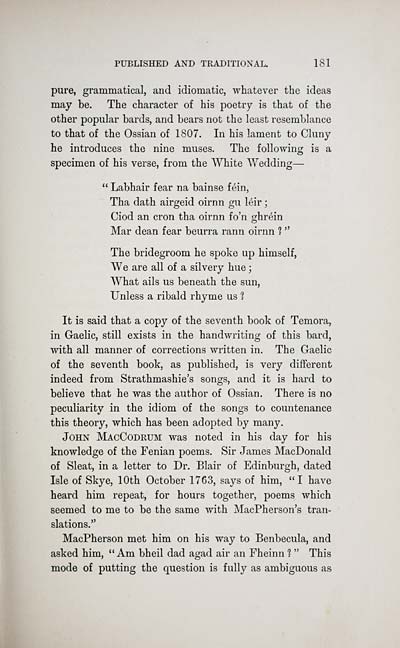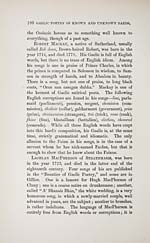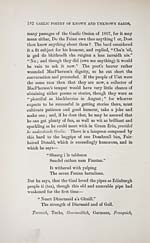Download files
Complete book:
Individual page:
Thumbnail gallery: Grid view | List view

PUBLISHED AND TRADITIONAL. 181
pure, grammatical, and idiomatic, whatever the ideas
may be. The character of his poetry is that of the
other popular bards, and bears not the least resemblance
to that of the Ossian of 1807. In his lament to Cluny
he introduces the nine muses. The following is a
specimen of his verse, from the White Wedding —
" Labhair fear na bainse fèin,
Tha dath airgeid oirnn gu lèir ;
Ciod an cron tha oirnn fo'n ghrein
Mar dean fear beurra rann oirnn 1 "
The bridegroom he spoke up himself,
We are all of a silvery hue ;
What ails us beneath the sun,
Unless a ribald rhyme us ?
It is said that a copy of the seventh book of Temora,
in Gaelic, still exists in the handwriting of this bard,
with all manner of corrections written in. The Gaelic
of the seventh book, as published, is very different
indeed from Strathmashie's songs, and it is hard to
believe that he was the author of Ossian. There is no
peculiarity in the idiom of the songs to countenance
this theory, which has been adopted by many.
John MacCodrum was noted in his day for his
knowledge of the Fenian poems. Sir James MacDonald
of Sleat, in a letter to Dr. Blair of Edinburgh, dated
Isle of Skye, 10th October 1763, says of him, "I have
heard him repeat, for hours together, poems which
seemed to me to be the same with MacPherson's tran-
slations."
MacPherson met him on his way to Benbecula, and
asked him, "Am bheil dad agad air an Fheinn 1 " This
mode of putting the question is fully as ambiguous as
pure, grammatical, and idiomatic, whatever the ideas
may be. The character of his poetry is that of the
other popular bards, and bears not the least resemblance
to that of the Ossian of 1807. In his lament to Cluny
he introduces the nine muses. The following is a
specimen of his verse, from the White Wedding —
" Labhair fear na bainse fèin,
Tha dath airgeid oirnn gu lèir ;
Ciod an cron tha oirnn fo'n ghrein
Mar dean fear beurra rann oirnn 1 "
The bridegroom he spoke up himself,
We are all of a silvery hue ;
What ails us beneath the sun,
Unless a ribald rhyme us ?
It is said that a copy of the seventh book of Temora,
in Gaelic, still exists in the handwriting of this bard,
with all manner of corrections written in. The Gaelic
of the seventh book, as published, is very different
indeed from Strathmashie's songs, and it is hard to
believe that he was the author of Ossian. There is no
peculiarity in the idiom of the songs to countenance
this theory, which has been adopted by many.
John MacCodrum was noted in his day for his
knowledge of the Fenian poems. Sir James MacDonald
of Sleat, in a letter to Dr. Blair of Edinburgh, dated
Isle of Skye, 10th October 1763, says of him, "I have
heard him repeat, for hours together, poems which
seemed to me to be the same with MacPherson's tran-
slations."
MacPherson met him on his way to Benbecula, and
asked him, "Am bheil dad agad air an Fheinn 1 " This
mode of putting the question is fully as ambiguous as
Set display mode to: Large image | Transcription
Images and transcriptions on this page, including medium image downloads, may be used under the Creative Commons Attribution 4.0 International Licence unless otherwise stated. ![]()
| Early Gaelic Book Collections > Matheson Collection > Popular tales of the west Highlands > Volume 4 > (197) |
|---|
| Permanent URL | https://digital.nls.uk/81489421 |
|---|
| Description | Volume IV. |
|---|---|
| Shelfmark | Mat.77 |
| Additional NLS resources: | |
| Attribution and copyright: |
|
| Description | Items from a collection of 170 volumes relating to Gaelic matters. Mainly philological works in the Celtic and some non-Celtic languages. Some books extensively annotated by Angus Matheson, the first Professor of Celtic at Glasgow University. |
|---|
| Description | Selected items from five 'Special and Named Printed Collections'. Includes books in Gaelic and other Celtic languages, works about the Gaels, their languages, literature, culture and history. |
|---|

